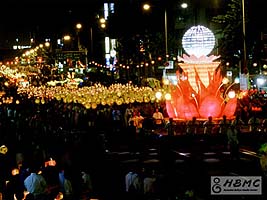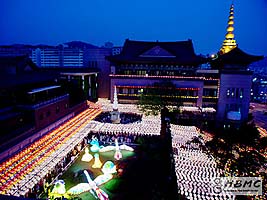 If the images do not appear or
you cannot see this email, click here to see the online version:
If the images do not appear or
you cannot see this email, click here to see the online version:
 Email exchanges are becoming
increasingly unreliable due to the various servers' efforts to thwart
unsolicited mail. If you would like to ensure delivery of our messages to
you, we recommend you add our domain – Korean-Arts.com - to your list
of acceptable correspondents (on Outlook Express: Tools > Junk Mail
Filter; on Netscape Communicator: Edit > Message Filter).
Email exchanges are becoming
increasingly unreliable due to the various servers' efforts to thwart
unsolicited mail. If you would like to ensure delivery of our messages to
you, we recommend you add our domain – Korean-Arts.com - to your list
of acceptable correspondents (on Outlook Express: Tools > Junk Mail
Filter; on Netscape Communicator: Edit > Message Filter).
|
The Korean-Arts’
Monthly* Newsletter for May 01, 2007
|
Jewelry
Scroll
Paintings
More
|
New
Items…
 Jewelry
Jewelry
|
Inspired in by the popular Korean historical drama Hae-sin and the authentic costumes it brings
to the screen, our new earrings combine the authentic touches of jewelry of
the Shilla Dynasty yet, have a modern
flair. We have seven new designs including the Black Chandelier Mother of
Pearl Earrings shown at right, and six other designs. All our jewelry is designed and created one at a time by hand, using the finest
quality gemstones; turquoise, jade, onyx, and other materials such as,
sterling silver, mother of pearl, and coral. Since each piece is made one at
a time, we will only carry limited quantities and will make new pieces as
they are ordered. So there is a possibility that the jewelry you order may be
delayed by a week or so while it is being made. In such cases, we will,
naturally, inform you. See
our new earrings here and our entire jewelry
selection here!
|
 Paintings
Paintings
|
We have several new
smaller scroll paintings for hanging in smaller areas and apartments
featuring classic scenes of mist filled Korean mountains and valleys, and a
larger scroll painting with the traditional theme of bamboo, one of the four
gracious plants. Bamboo stands for integrity and also represents winter
because it bares its green leaves even in the snow. We also have a number of
other scroll paintings on sale at low prices. See our new scroll paintings here,
all our paintings
here, and our paintings on sale here.
|
 More
More
|
The Mal-dduk-i
or servant mask, shown, is a hand-carved and painted, full-sized mask such as
that used during the traditional Korean mask dance (Tal-chum),
and features a cloth hood to cover the performers head. The original
meaning of the Tal-nori (Tal play),
or Tal-chum (Tal dance),
is a play or dance that helps shed ones stress and grief. During the Koryo Dynasty there was a
considerable amount of social tension and the lower classes found a way to
relieve not only their everyday stresses, but the tensions which existed
between the many social classes in Korea, through the Tal-nori.
The plays often satirized upper classes of society by portraying the Yang-ban, or aristocrats, with deformed
faces. Read more about the Korean
mask dance here. We also have new Bun-cheong
plates with a design from the Chosun Dynasty. See all our new items here.
|
|
On Sale Now
|
Three new scroll paintings from our Four
Gracious Plants collection, two bamboo, and one wild orchids painting,
are reduced to nearly half price. Additionally, one teapot set and five of
our celadon teacup sets with built in strainers are on sale and make perfect,
and inexpensive, gifts. To help make gift-giving easier we have also reduced
the price of gift-wrapping. See all our sale items here.
|
|
|
|
 Buddha’s Birthday in Korea:
Buddha’s Birthday in Korea:
Most
traditional Korean holidays are celebrated on the lunar calendar and so
change on the solar calendar each year. This year Buddha’s birthday
will be on 4/08 on the lunar calendar which is 5/24 on the solar calendar.
Preparations for the event begin several months in advance by decorating many
of the major streets with strings of lanterns. The week of the birthday there
are generally a number of events leading up to the day and this year include
a lantern lighting festival in front of city hall on the 5/09, lantern making
festivals at most of the Buddhist temples 5/19, and in downtown Seoul in
front of Jo-gye-sa
(one of the largest temples and the largest Buddhist sect in Korea) a
Buddhist street festival during the day on 5/20.
 |
That
evening there is a large lantern parade going down the main street of Jong-ro
(one of the main streets in Seoul). The
parade is an extravagant affair that goes non-stop for two and a half hours,
represents Buddhist sects from all over Korea,
and the world, and showcases hundreds of floats and over 100,000 lanterns.
See more pictures from the lantern festival here.

|
The
day of Buddha’s birthday the temples are decorated with thousands of
lanterns and are lit at night. Scores of people visit the temples throughout the
day and into the evening to pray, see the beautiful lanterns or simply
partake in the atmosphere. Traditional Korean food and rice wine is also
served on the grounds and contribute to the pleasant atmosphere. Up until
several years ago, the lanterns were lit with real candles and walking under
them was quite an affair as the hot wax would drip onto ones head with each
gust of the wind. Nowadays, electric lights are used and the event is a bit
safer, although not such an adventure.
See more pictures from the Buddha's birthday celebration at
Jo-gye-sa temple here.
 The Real Buddha
The Real Buddha
“Buddha”,
was born as a prince in Northern
India in about 563 BC (some scholars
disagree on this) as Siddhartha Gautama, the son of
King Shuddhodana and Queen Mayadevi.
India was at that time a Hindu society in which reincarnation was
accepted and it was thought life on earth was but a series of reincarnations.
The goal then was to avoid the endless series of reincarnations, and the
suffering that accompanied them, and achieve Nirvana. Into this society,
Prince Gautama was born and raised in a life of
luxury, married and had a son, and led a normal life up until the age of
twenty-nine at which time he left his home to become a religious wanderer (a
common practice at the time). He studied under several masters during that
time and engaged in fasting, often to near death, to achieve a higher level
of meditative enlightenment. Finally, one day while meditating under a tree,
later known as the tree of enlightenment, he achieved a state of
enlightenment, said his rebirths were over and stated that he had entered
Nirvana even while in his present life. He had become the
“Buddha”. He spent the remainder of his time spreading word of
the path to enlightenment.
His
doctrine, and path to achieving Nirvana, says that existence is an evil and
can be eliminated by getting rid of desires of life and things of sense. By
achieving this state in which there is a complete lack of desires and
practicing the eight precepts of the way to Nirvana which include in part,
celibacy, the practice of good deeds, and contemplation, one can achieve
Nirvana at, or even before, one’s death.
 Buddhism
in Korea
Buddhism
in Korea
Early Buddhism was introduced into Korea at the end of the
fourth century from China but took on a
unique style of its own under the early rulers of the royal court who used
the religion as a faith of national defense and prayer. They also
consolidated the various sects which had not been accomplished in Chinese
Buddhism. Due to Buddhism in Korea being tied to the
royal court, in the late eighteenth century, the Japanese used the
introduction of their style of Buddhism and their temples into Korea as a political
tool to aid in the eventual annexation of Korea which occurred in
1910. To this day there is a rift amongst the sects of Korean Buddhism which
was caused by the introduction of the Japanese sects. Korea currently is about
26% Buddhist, 26% Christian, 46% no affiliation and 2% other. Although, only
26% of the population is Buddhist, many more than that enjoy watching the
lantern festival and partaking in the other activities associated with the
Buddha’s birthday celebration much like many non-Christians celebrate
Christmas in the West.
Fortunately for us, the influence of
Buddhism during the Koryo Dynasty, and the need of the temples, and
likewise the royal court, for fine vessels to be used during the many ritual
ceremonies, was largely responsible for the development of what is now known
as Korean celadon and a general flourishing of the arts of the period.
 Additional Links
Additional Links
|
Subscribing-Unsubscribing
|
We at Korean-Arts appreciate your
patronage and do not wish to send unsolicited mail. We send our newsletter
once to each new customer, and monthly* to continued subscribers. If you
would like to be removed from our mailing list for any reason, click on the
link below and send the new email that appears.
Should a new email message not
appear, reply to this email with the word “UNSUBSCRIBE” in the
subject line.
Keep up-to-date! Would you like to be
informed of our special offers, sales, and new merchandise? Would you like to
learn more about the the arts of Korea, Korean life, and
customs? Click on the link below and send the email that appears and we will
inform you of our new products as they become available, specials, and
informative articles about the history, and meaning of the beautiful artworks
of Korea, and other small articles about life in Korea and Korean customs.
Your name and email address will remain confidential and will not be used
outside our site. Please see our privacy policy for
details.
Questions or Comments: We would love
to hear from you. If you would like to ask any questions about the arts of Korea, or have any
comments contact us at.
Sincerely
The Korean-Arts staff
|
*Generally, we send a newsletter
every month, but may delay it until we have new items or specials.
Copyright
© 2002-2007 Korean-Arts.com All rights reserved.
|














